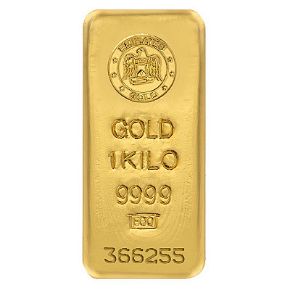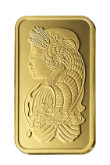
Gold bars are a valuable asset, and ensuring their authenticity is essential to protect your investment. While professional testing is the most reliable way to verify the purity and legitimacy of gold, there are several simple and effective methods you can use at home to test gold bars. These methods can help identify counterfeit bars or those made from other metals coated in gold. Below is a comprehensive guide to testing gold bars at home.
Key Characteristics of Genuine Gold Bars
Before testing, it’s important to know the basic properties of gold that make it unique:
- Density: Gold is a dense metal with a specific gravity of 19.32 g/cm³, making it much heavier than most other metals.
- Non-Magnetic: Gold is non-magnetic, meaning it will not be attracted to magnets.
- Softness: Pure gold is a relatively soft metal that is malleable and easy to scratch.
- Color: Pure gold has a distinct bright yellow color.
Using these properties, the following tests can help you determine whether your gold bar is genuine.
Home Tests for Gold Bars
1. Visual Inspection
Examine the gold bar closely for markings, weight, and design. Genuine gold bars will have the following details:
- Mint logo (e.g., PAMP Suisse, Valcambi, Perth Mint)
- Weight (e.g., 1 oz, 10 oz, or 1 kg)
- Purity (e.g., 999.9 for 24-karat gold)
- Serial number
Compare the bar with images from the official mint’s website to check for any discrepancies in the design, size, or details. Counterfeit bars often have poor-quality engravings or incorrect markings.
2. Magnet Test
Gold is non-magnetic, so it will not be attracted to a magnet. Use a strong magnet, such as a neodymium magnet, to test your gold bar. If the bar is attracted to the magnet, it is likely made of a magnetic metal (e.g., iron or nickel) and is not pure gold.
How to Perform:
- Place the gold bar on a flat surface.
- Slowly bring the magnet close to the bar.
- Observe whether the bar reacts to the magnet.
3. Weight and Size Check
Each gold bar has precise specifications regarding its weight and dimensions. Use a digital scale to weigh the bar and calipers to measure its dimensions. Compare these measurements to the specifications provided by the mint or refiner.
How to Perform:
- Weigh the gold bar on a digital scale. For example, a 1-ounce gold bar should weigh exactly 31.1 grams.
- Use calipers to measure the length, width, and thickness of the bar.
- Verify the weight and dimensions with official specifications.
4. Scratch Test
Gold is a soft metal, and scratching the surface can reveal whether the bar is made of gold or coated with another material. This test, however, can damage the bar, so it is not recommended for collectible or investment-grade gold.
How to Perform:
- Gently scratch the surface of the bar using a small file or sharp object.
- If the color beneath the surface is different, the bar is likely gold-plated and not pure gold.
5. Acid Test
The acid test is a chemical method used to determine the purity of gold. Gold is resistant to most acids, so applying acid to a bar will not affect it if it is genuine. Acid testing kits are available online and come with instructions for use.
How to Perform:
- Rub the gold bar gently on a black stone (provided in the kit) to leave a small streak.
- Apply the testing acid to the streak.
- Observe the reaction. Pure gold will not react to the acid, while other metals may dissolve or change color.
6. Specific Gravity Test
Gold has a unique density, and the specific gravity test can help verify its authenticity. This test requires a precise scale and a container of water.
How to Perform:
- Weigh the gold bar in air and note the weight.
- Submerge the bar in water and weigh it again.
- Divide the weight in air by the difference between the two weights to calculate the specific gravity.
- If the result is close to 19.32, the bar is likely genuine.
7. Ping Test
Gold produces a distinct sound when struck gently. The ping test involves tapping the gold bar and listening for a clear, high-pitched ring.
How to Perform:
- Hold the gold bar in one hand.
- Tap it gently with another metal object or coin.
- Listen for the sound. A pure gold bar will produce a resonant tone, while counterfeit bars made of other metals will sound dull.
8. Thermal Conductivity Test
Gold is an excellent conductor of heat. The thermal conductivity test involves observing how quickly the gold bar transfers heat.
How to Perform:
- Place an ice cube on top of the gold bar.
- Observe how quickly the ice melts. A genuine gold bar will conduct heat quickly, causing the ice to melt faster than it would on other metals.
9. Hallmark Verification
Check the hallmark or serial number on the gold bar. Many mints include a serial number that can be verified online. For example, some refiners, such as PAMP Suisse, allow you to check the serial number on their official website to confirm the bar's authenticity.
10. XRF (X-Ray Fluorescence) Scanner
If you have access to an XRF scanner, this method can analyze the composition of the gold bar without damaging it. While this technology is typically used by professionals, some portable devices are available for home use.
What to Do If Your Gold Bar Fails a Test
If your gold bar fails one or more of the above tests, it may not be genuine. Take the following steps:
- Do not sell or trade the bar until its authenticity is confirmed.
- Take it to a professional appraiser, jeweler, or bullion dealer for further testing.
- Contact the seller or mint where you purchased the gold bar to report any issues.
Best Practices When Buying Gold Bars
To avoid counterfeit gold bars, always purchase from reputable sources. Look for dealers who are members of recognized organizations, such as the Professional Numismatists Guild (PNG) or the American Numismatic Association (ANA). Additionally:
- Request a certificate of authenticity for each bar.
- Avoid deals that seem "too good to be true."
- Verify the bar’s serial number with the issuing mint if possible.
Advanced Methods for Testing Gold Bars
While home testing methods are helpful for initial verification, advanced testing techniques provide a more conclusive assessment. These methods require specialized equipment and are often used by professionals, but some tools are available for personal use.
Ultrasound Testing
Ultrasound testing is a non-invasive method that uses sound waves to measure the density and internal structure of the gold bar. Authentic gold has a unique sound wave signature, and deviations can indicate the presence of counterfeit metals, such as tungsten, which has a similar density to gold.
How to Perform:
- Use a portable ultrasound device designed for gold testing.
- Place the device's probe against the gold bar.
- Analyze the results on the device’s screen to ensure the density and composition match pure gold specifications.
This method is highly accurate and especially useful for large gold bars, where counterfeit materials are more commonly used to replicate gold's weight.
Electrical Conductivity Testing
Gold is an excellent conductor of electricity. Measuring its electrical conductivity can help determine its purity and detect any impurities or counterfeit metals.
How to Perform:
- Use a gold conductivity meter.
- Place the probes on the surface of the gold bar.
- Compare the conductivity reading to the expected range for pure gold.
This method is fast and non-destructive, making it a preferred choice for many professionals.
X-Ray Fluorescence (XRF) Testing
XRF is one of the most accurate and advanced methods for analyzing the composition of a gold bar. It works by exposing the bar to X-rays, which causes the atoms in the gold to emit secondary X-rays. These emissions reveal the metal's exact composition and purity.
How to Perform:
- Place the gold bar in the XRF scanner.
- Allow the machine to analyze the bar.
- Read the results, which will display the percentage of gold and other metals present.
XRF testing is often used by bullion dealers, refiners, and mints to ensure the quality of their products. Portable XRF machines are available for individuals but can be expensive.
Laser Engraving Verification
Some gold bars, especially those from well-known refiners like PAMP Suisse and Valcambi, come with advanced laser-engraved security features. These features can include microscopic text, images, or holograms that are difficult to counterfeit.
How to Perform:
- Use a magnifying glass or microscope to inspect the engraving.
- Compare the design and details to the official mint specifications.
These advanced security features, when paired with other testing methods, make counterfeiting much harder.
Why Professional Verification May Be Necessary
While home testing methods are valuable, professional testing can provide a definitive answer. Certified appraisers, jewelers, and bullion dealers have access to tools and techniques that aren’t practical for home use. If your gold bar represents a significant investment or if you suspect it might be counterfeit, professional verification is highly recommended.
When to Seek Professional Verification
- You’re buying or selling a gold bar with a high value.
- The gold bar failed one or more home tests.
- You need official documentation to confirm authenticity.
- You suspect the bar might have been tampered with or altered.
Where to Have Gold Bars Professionally Tested
- Bullion Dealers: Most reputable gold dealers offer testing services, often using XRF or ultrasonic equipment.
- Jewelry Appraisers: Certified jewelers and appraisers are equipped to verify gold authenticity and provide certificates.
- Refineries: Precious metal refineries can perform detailed purity tests and, in some cases, melt the bar for accurate results.
Always choose a trusted professional or institution to avoid further complications.
Common Red Flags for Counterfeit Gold Bars
To avoid counterfeit gold bars, be aware of the following warning signs:
- Suspiciously Low Prices: Gold bars priced significantly below the market value are likely counterfeit or of lower purity.
- Missing or Inaccurate Markings: Genuine gold bars always include details like weight, purity, and mint logo. Counterfeit bars may have poorly engraved markings or lack them altogether.
- Incorrect Weight or Dimensions: A bar that doesn’t match official specifications in weight or size is likely fake.
- Unfamiliar Sellers: Avoid buying gold bars from unverified or unknown sources, especially in private sales or online marketplaces.
Tips for Storing Gold Bars Safely
Once you’ve verified the authenticity of your gold bars, proper storage is critical to maintaining their value. Gold is highly durable, but improper handling or exposure to certain conditions can damage its appearance or diminish its market value.
Use a Fireproof Safe
Store gold bars in a fireproof and waterproof safe to protect them from theft and natural disasters. Choose a high-quality safe that is difficult to move or break into.
Bank Safety Deposit Box
For additional security, consider storing gold bars in a bank’s safety deposit box. This option keeps your gold offsite and protected by the bank’s security measures.
Avoid Frequent Handling
Minimize handling of your gold bars to prevent scratches, dents, or fingerprints. Always use gloves when handling gold to maintain its pristine condition.
Store in Protective Packaging
Keep gold bars in their original packaging or use specially designed protective sleeves. This prevents damage and ensures the bar retains its resale value.
The Importance of Testing and Storing Gold Bars
Gold bars are a long-term investment that can preserve wealth and protect against economic instability. However, the market for counterfeit gold is growing, making testing and storage crucial for safeguarding your assets. By combining reliable home testing methods with professional verification and secure storage, you can ensure the authenticity and integrity of your gold bars.
Gold remains one of the most trusted and enduring assets in the world. Whether you’re a seasoned investor or a first-time buyer, taking the time to verify and protect your gold bars will help you preserve their value for years to come.
NOTE
This Content is the copyrighted content of EE.GOLD. All rights are reserved. You are welcome to share or use our content only by including direct links to our website. Any other form of reproduction, distribution, or use without proper attribution is strictly prohibited.
This Content is intended solely for educational purposes. The information provided does not constitute financial or investment advice.
Please note that Digital Storage Receipt, Secure Storage Solutions, and Physical Gold Sales are the only services offered by EE.GOLD.
We strictly adhere to government regulations and are firmly against all illegal financial or investment activities globally.
For further inquiries, feel free to contact us through our official channels.










.png)

